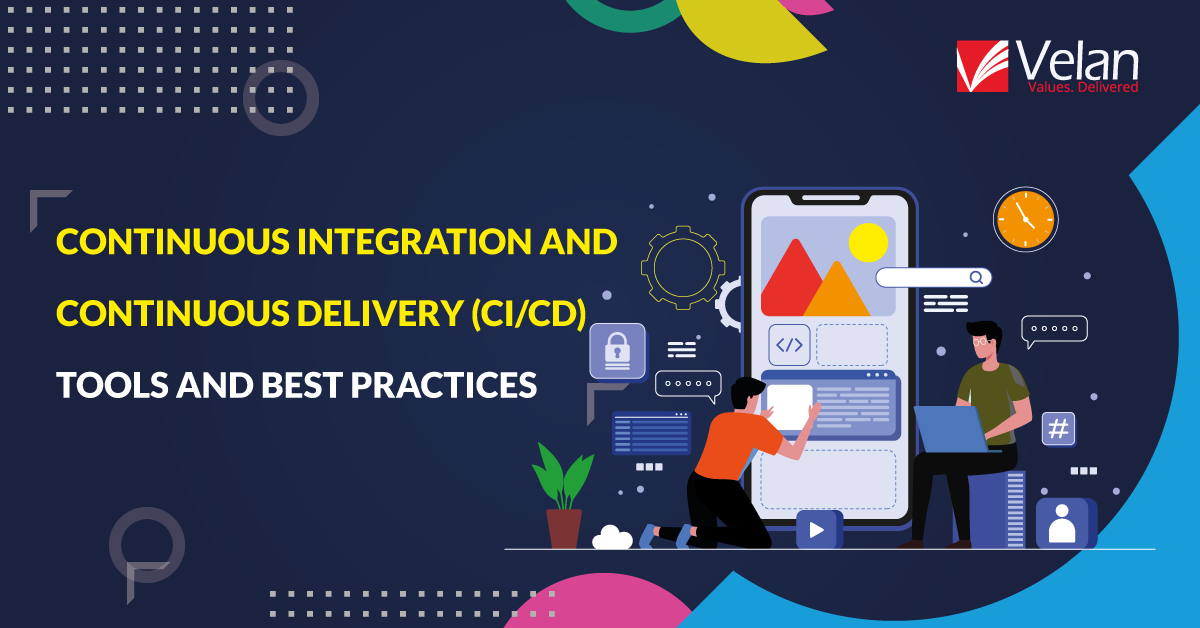Continuous Integration And Continuous Delivery (CI/CD): Tools And Best Practices 17 Aug 2021

Along with introducing new products and services to the market, the requirements of the modern digital business landscape demand that businesses accomplish both reliability and speed. It requires to be in tandem and not any point up or down. To meet this challenging demand, organizations are embracing DevOps practices — like continuous integration and continuous delivery (and its associated practice of continuous deployment), collectively known as CI/CD.
These interconnected processes enable the developers to build high-quality software via streamlined and automated development, testing, delivery, and deployment. The process guarantees better collaboration, increased communication, and greater efficiency for DevOps teams throughout the software development life cycle.
With more than 60% of organizations living on DevOps last year, continuous integration (CI) and continuous delivery (CD) have become an indispensable part of the software development process. Believe it or not, your business is already plunging into a DevOps transformation per se. We will discuss the CI/CD best practices, their relationship, and how these practices will help your organization accelerate adoption, optimize more processes, and achieve greater results.
CI/CD is a belief that reinforces robust tooling and emphasizes automated testing at every stage of software development. It has a multitude of benefits, however, it demands great study and consideration. Although every implementation is distinct, complying with the best practices will help you overcome common problems and achieve faster improvements.
CI/CD best practices
● Keep your pipelines faster and cheaper.
Waterfall methodologies are a negation to meet the evolving technology demands and challenges in the software development life cycle. And that’s where an Agile methodology fills the gap – helping developers to test faster and deploy. The strategy here is to relocate responsibilities and activities left within the software delivery process.
For example, you must introduce the developer environments for early testing and not wait till the deployment stage. By doing so, you as an organization will empower and help your developers to build the skills that require them to act fast, yet informed without damaging things.
The core intention of a CI pipeline is to automate the build process. Your build process should entail issue tracking and version control along with integration and running unit tests. It will enable the codes to fail faster, which does not meet any functional requirements. A common issue in CI is having insufficient unit tests. It can sometimes pass through the CI pipeline, however, fail further into the software delivery process.
The process of failing quicker in a CI/CD pipeline is highly beneficial in terms of efforts and cost. It is because the end-to-end testing methods are difficult to debug, expensive, and require various services to run on the infrastructure. The best practice is to identify and debug an issue before it reaches the customer. Incorporating a robust environment for unit tests in your CI/CD pipeline will help your teams identify the bugs, fail faster and quicker, and cut back any issues in its budding stage, so the deployment will be successful.
● Have a reliable environment.
Having your organization receptive to a robust CI/CD pipeline will help your team build and deliver the software application faster. However, it is possible only with the right set of tools. It takes one to build one is the scenario in DevOps to scale and grow your organization to meet your objectives. Besides, your test environment should be flexible to test multiple use cases and the requirements needed to deliver the software. Building a reliable CI/CD pipeline is the key.
● Commit daily but after running the tests locally.
In association with the previous discussion about keeping your failures quicker and cheaper, developers must run local tests before committing to the shared environment. It makes identifying any error before it hits the other team members. Although the developer will not have the luxury of a real-time test environment to run the local tests, doing so will give them more confidence to get through basic issues and empower them to integrate into the real-time shared environment.
Your test suite must operate with a single command to ensure that the developers can test on their own. And that same command must work for the CI/CD system to kick off tests on code integrated with the repository. Mostly, this is a joint action by providing a makefile or shell script to automate the testing tools in a predictable, repeatable manner.
● Run and build in a separate test environment.
It is important to run CI/CD pipelines in a separate environment. It will ensure security and resemble the staging and production environment leading to accurate test results.
You can use Docker or any other containerized tools along with auxiliary tools to run the tests for your software application. This process will ensure zero inference with the main host. This process helps to validate that the tests are independent and capable enough to merge with one or more projects.
● Run tests in a transient test environment.
Running your tests in a transient test environment will ensure multiple tests can be run at different stages. It means running tests in containers to extract differences between the host systems and to offer a standard API to integrate different components at multiple levels. Containers run at a minimal state, and it will ensure that the persisting results from the subsequent runs will not affect the final results.
Another benefit of containerized testing environments is the easy portability of your testing infrastructure. Using containers will give the developers the luxury to replicate the configuration that can be used later in the pipeline. It would not require manual setup and infrastructure maintenance. Besides, users need not make compromises in their testing suite when running local tests. By and large, using containers fastens the runtime environment to minimize differences between different pipeline stages.
● Rectify and restore the broken builds.
It is important to fix and restore broken builds. The main purpose of continuous integration is to enable your teams to work on steady code versions. If your teams are struggling to get that right and keep your code stable, ensure that your build and test processes are available and visible to your development team.
Ideally, every version of code gets built only once by a CI pipeline. It is because the failures and the corresponding code changes can be readily tracked and comprehended. Clean testing environments that are built on-demand and separated from other application activities can also prove beneficial that CI/CD pipelines assure. Building CI/CD pipelines to provision and control quality assurance (QA) or testing environments has proven useful for QA teams and software development that are aiming to deliver their application with high quality, accuracy, and speed.
● Make the CI/CD Pipeline the only gateway for deployment.
Tooling is one of the important things that make CI/CD improve your code quality and development practice phenomenal. Using the right tools is directly dependent on enforcing the best practices for testing and deployment. Promoting code through your CI/CD pipelines demands every change to be accountable and meet your company’s codified protocols and standards. Failures in a CI/CD pipeline become visible immediately and stop the progress of the problematic release to later stages of the cycle. It is a controlling mechanism that protects main environments from skeptic code.
In order to reap these advantages, you must make your CI/CD pipeline the only gateway for deployment. You must train your team members to stick to this routine religiously and make sure every change in the production environment goes through the pipeline only. It can happen automatically after successfully testing the continuous deployment practices, or through a manual step after the tested changes are approved and made available by your CI/CD system.
● Retain parity between staging and production.
CI/CD pipelines promote changes through various test environments and deployment suites. Those changes are either automatically deployed or lined up for manual deployment. Every stage confirms that it is advantageous and positive to continue testing and push the changes to production.
For later stages, having a clone of the production environment will help the tests reflect accurately and also show how the changes would behave in production. Notable disparities between staging and production will detect and release problematic changes which were never observed defective during the testing phase. The more disparities between your testing environment and the live environment, the less your tests will measure how the code will perform when released. Ensure to keep the differences in control, and they are clearly understood. A few organizations depend on “Blue-Green” and “Canary” deployment strategies where they deploy their application on production with 1% live traffic and closely observe it, which later promotes for the production with 100% traffic or defaults to previous releases.
● Run your fastest tests promptly.
Please note that a few parts of your test suites will be inevitably faster than the others. Identify those tests and run them faster. It will help you discover failures, save complex tests, and minimize problematic builds. This strategy will help to maintain the health of your CI/CD pipeline. It will also help you understand the performance of individual tests and increase the overall deployment time, which means that the problematic builds and changes can be soon reverted or fixed before blocking other developers’ work.
How to select the right tool?
DevOps pipelines are complicated. It demands knowledge and effort to select the right tools for every stage of a process, unify them with each other, and customize them for your organization’s needs. Specific tools for code testing or containers have similar functionalities however, middleware for CI/CD and configurations are challenging.
Understand your team’s skill set and decide which members will be working with the tools you select. The CI/CD tools will certainly vary in languages available for configuration methods and programming. For a team whose forte is development, we recommend imperative methods, and for the operation squad, we recommend declarative methods.
Perform the activities below before you select the tools. It must be performed when the pipeline is up and running.
- Gauge your tech stacks to calculate the efficiency and accessibility of your existing system.
- Proactively examine new tools for the pipeline or keep looking in the market to find new tools that could replace the existing ones. (Trust us, when we say you need experts like Velan to do this job!)
- Conduct timely tool experiments.
- Initiate team discussions to understand the tools’ effectiveness and the readiness to migrate to a new tool.
Takeaway
The most important thing about DevOps’ Continuous Integration and Continuous Deployment is it preaches and follows Agile Methodology. It is practiced religiously by many organizations owing to the very many benefits it provides to them. The most important of all the benefits is its ability to ship software directly, and securely. It helps the companies to release their software code faster and frequently, leading to multiple releases in a day.
Every CI/CD implementation process is different and customizable. However, adopting these tried and tested basic principles will strengthen your testing and deployment practices and save you some common problems. As far as continuous integration is concerned, tooling, best practices, processes, and discipline make development changes impactful and successful in your organization.
To understand the CI/CD practices and how to adopt these services in your organization, get in touch with our DevOps consultant. From helping you adapt to DevOps, following the bespoke best practices religiously in your organization, and leveraging the right tools while keeping up with the technology trends, we, at Velan, can help you deal great.





